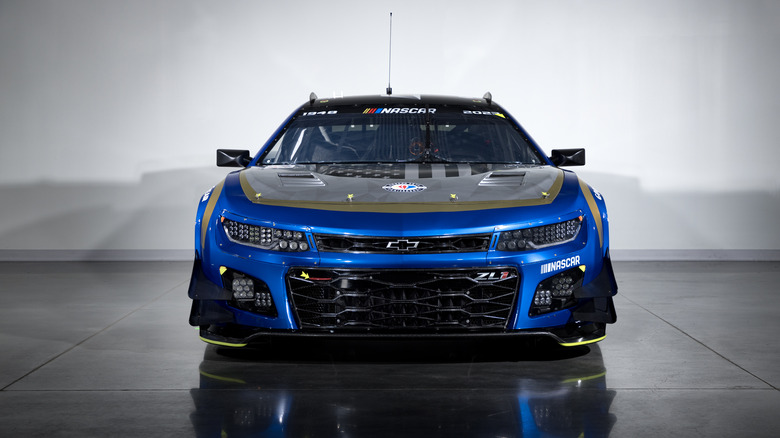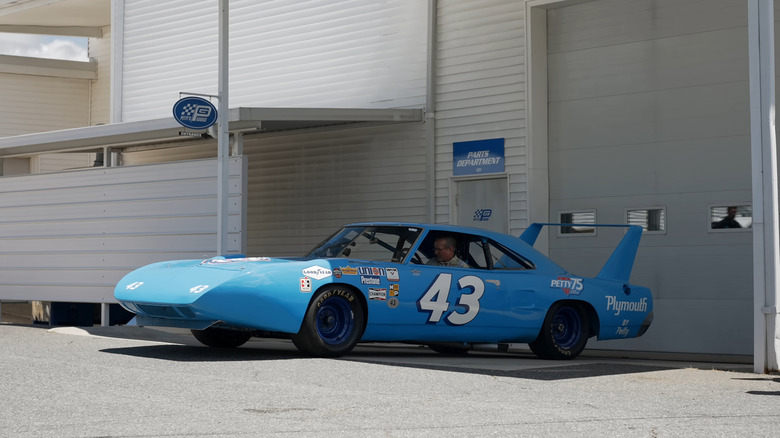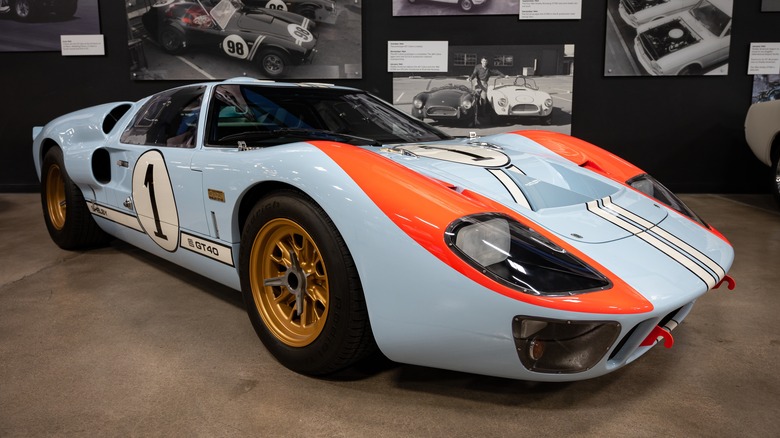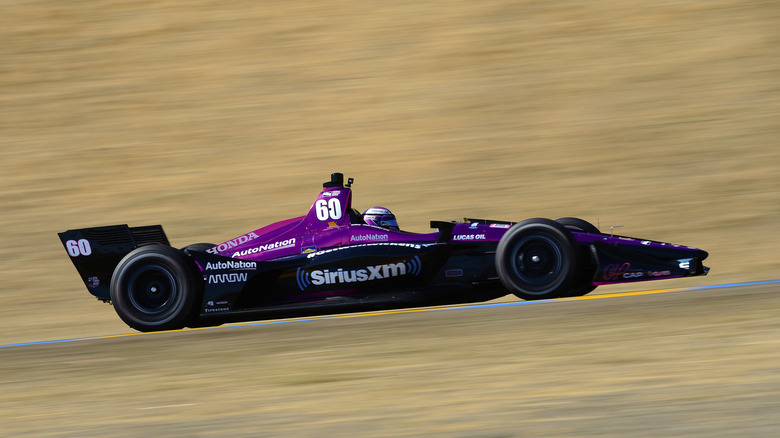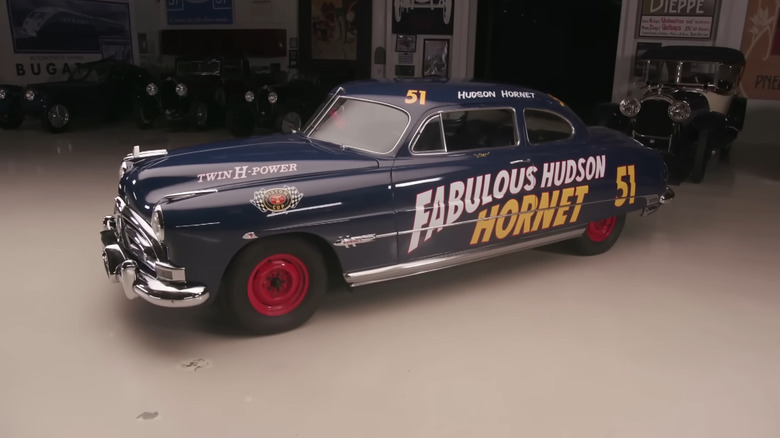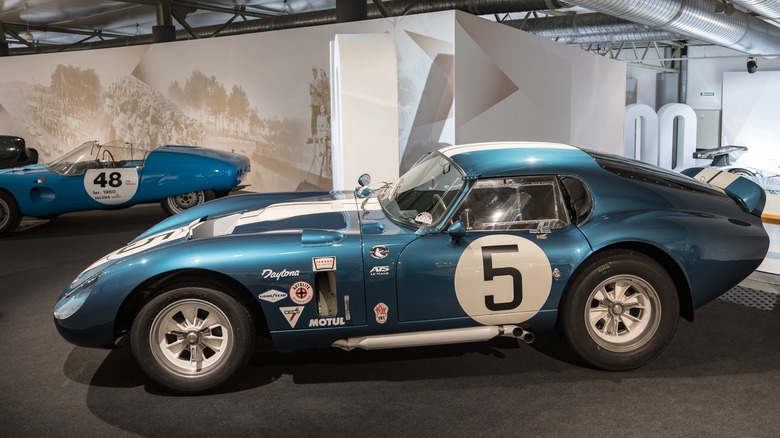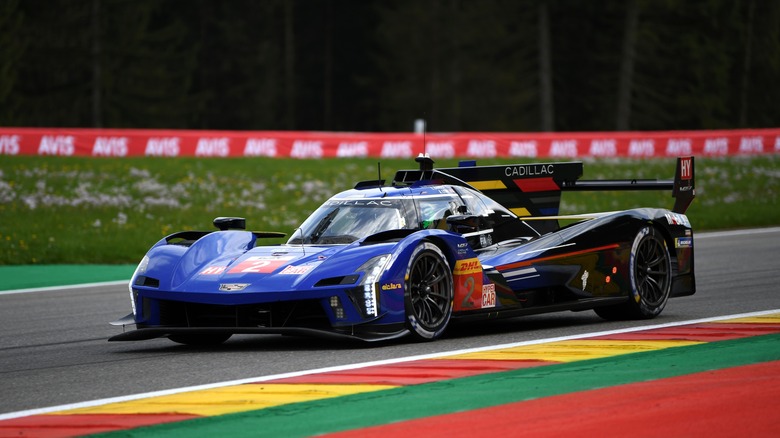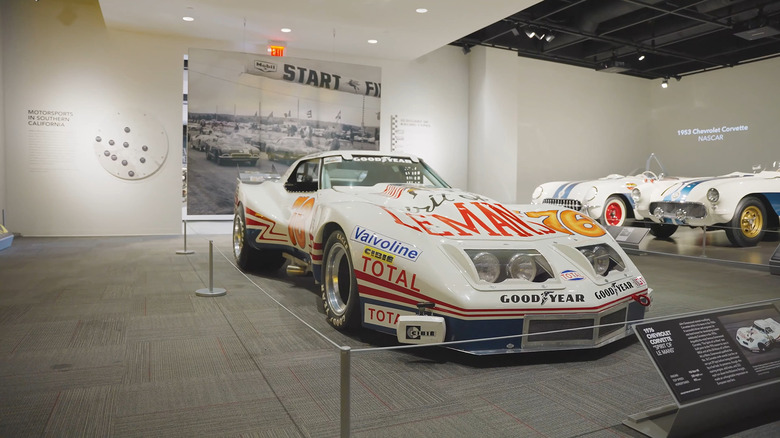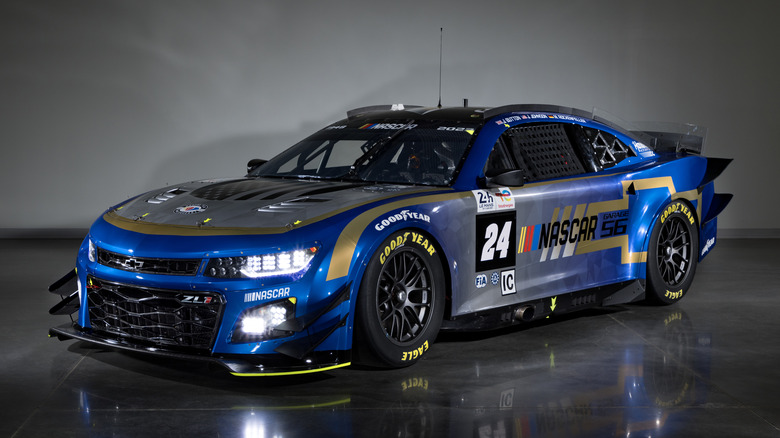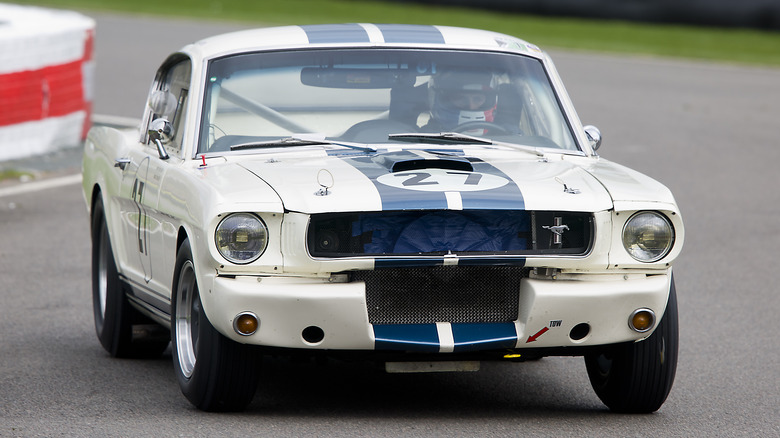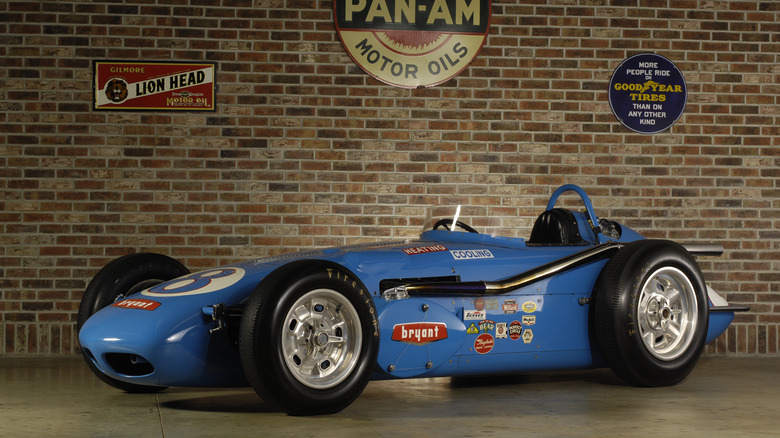10 Of The Best-Looking American Race Cars Ever Made
For over a century, Motorsport has been deeply rooted in the legacy of the American automotive industry. Many major manufacturers that helped put the nation on the map for racing provided us with some of the greatest racecars ever built, seeing success in whichever category they competed in. As new championships were founded, all this did was pose a new challenge for the likes of Ford, Chevrolet, and Cadillac to add as many trophies to their cabinets as possible.
Developing a racecar is no small feat. It takes seriously talented individuals to produce a race-winning car, but it's even rarer for them to look as good as they are fast. Achieving the highest top speed or maximum aerodynamic efficiency doesn't always correlate with style, but these 10 cars manage to blend the two and create some of the most stunning racecars motorsport has ever seen. It's not uncommon for American teams to outsource components from foreign countries, sometimes even the chassis of their car, but the following models in this list couldn't have been brought to life without American engineering.
Richard Petty's 1970 Plymouth Superbird
When it comes to the most popular motorsports in the U.S., none manage to top NASCAR. The racing series can trace its roots all the way back to 1948, where the first official race took place at Daytona Beach, Florida, and has since evolved into one of the most unique motorsport series without diverting from its core foundations in stock racing. There have been quite a few jaw-dropping cars to race on the nation's world-famous oval tracks, but Richard Petty's blue 1970 Plymouth Superbird is a car that's become synonymous with the early '70s era of NASCAR.
After seeing the potential with the Dodge Daytona NASCAR, with its massive rear wing and aer-focused nosecone, Plymouth took the same route with the Road Runner to create the Superbird. Not all entries on the 1970 NASCAR grid followed the same style, with Ford competing with the Torino King Cobra and Chevrolet with the Monte Carlo.
This 1970 Plymouth Daytona didn't just look good; it was so fast that, along with the Dodge Daytona's success, it caused the winged design philosophy to be banned the year after the Superbird first hit the track. Using the Superbird at the high-speed circuits, Petty won a total of 18 races throughout the 1970 season. The Superbird got another rise to fame in the 2006 film "Cars", where Petty himself voiced the character of The King, who was based on the '70 Plymouth.
1966 Ford GT40 Mk II
Shifting focus to a different motorsport category with more of an international presence, endurance races are known to be one of the toughest. While many long-distance events are staple races in motorsport history, the 24 Hours of Le Mans has been the pinnacle of endurance racing since 1923. One of the greatest stories at the fabled race came in 1966, when the Ford GT40 MK II ended Ferrari's winning streak, becoming an all-American motorsport legend. The original 1964 Ford GT40 was based on the revolutionary mid-engined Lola GT, with Ford hiring the man who designed it to help create Ford's racecar. The MK II model doesn't look much different to the MK I, but subtle changes outside and major changes under the shell made it as fast as it was beautiful.
The base chassis was built in Slough, England, then shipped to Shelby American in California for completion and to become Le Mans-ready. Out of all the improvements made for the second version of the racecar, the inclusion of the 7.0-liter 427 cubic-inch engine required a larger engine bay to accommodate it. To further assist with cooling, a larger nose was also fitted to the GT40 MK II, which made the rather elegant GT40 MK I's design style a touch more aggressive while making it the world's best endurance racecar. Ford won the 24 Hours of Le Mans with the GT40 MK II in 1966, achieving a 1-2-3 finish.
2018 Schmidt Peterson Motorsports IndyCar
Formula One may be the pinnacle of open-wheel motorsport worldwide, but IndyCar has long since been the top category in the U.S. The first IndyCar race was held in Portland, Oregon in 1909, becoming one of the oldest racing series in the world. Ever since, the series has gone through tremendous evolution with countless manufacturers taking part. One of these is Dallara, an Italian company that has produced the chassis for every IndyCar team since 2008. The current generation of IndyCars was introduced in 2012 after Dallara opened its new facility exclusively for IndyCar in Indiana, and the lineup that Schmidt Peterson Motorsports entered for the 2018 season still stands out as one of the best-looking in recent history.
The current third generation of cars is already naturally a joy to look at, but the liveries that this Indianapolis-based company put to use seven years ago only enhanced it. While simple, each of the three cars used a primary color on the top half of the cars, with one using gold, another using pink, and the third using red, all in contrast with a black bottom half. The chrome finish of the colors made the Schmidt Motorsports cars so distinct when going wheel-to-wheel with the rest of the field. The gold-colored car won the 2018 Iowa Corn 300 with James Hinchliffe behind the wheel, which would be the team's only victory that year. McLaren acquired Schmidt Peterson Motorsport in 2021.
1951 Fabulous Hudson Hornet
Considering that "Cars" is all about NASCAR racing, it's no surprise to see the film include other iconic real-life cars that had an incredible impact on the sport besides Richard Petty's Superbird. There are plenty of cars to choose from, but when it comes to the cars that keep you fixated on them, the 1951 Hudson Hornet is hard to beat. Hudson's car followed suit with many other American cars from the 1950s with its bold, full-size design, but by going for a step-down philosophy complete with streamlined side panels that covered much of the rear wheels, the Hornet had an edge over the competition for both performance and style.
Built in Detroit, Michigan, the Hudson Hornet was introduced to NASCAR at a time when manufacturers couldn't divert from the stock body and frame, meaning the racer looked almost identical to the car that you could purchase yourself. The 1951 Hornet took a similar direction to the 1970 Plymouth Superbird by using a solid block color for its livery, but this time using a darker blue with the iconic Fabulous Hudson Hornet graphic on the side. Another perfect example of less being more, but the natural beauty of the original Hornet puts it on another level compared to other NASCARs of its time. The Hudson Hornet won a total of 12 races in its debut season, eventually totaling a staggering 81 wins over the four years it raced.
1964 Shelby Cobra Daytona Coupe
A few years before Carroll Shelby embarked on the mission to bring Le Mans glory to Ford in 1966, his race team, Shelby American, was already competing at the highest level of sports car racing elsewhere. After he stopped racing in 1960, he turned his attention to manufacturing the world's best racecars instead of driving them, which started with the Legendary Cobra being the first. Using a shell manufactured by AC in the U.K., the original Shelby Cobra used two versions of a Ford V8 engine under the hood, which proved to be competitive, but Shelby American went a step further with the convertible model and created the Daytona Coupe to compete with Europe's best on their home turf.
The Shelby Cobra Daytona Coupe was designed by Peter Brock and introduced in 1964. Significant changes were made for the Coupe version of the Cobra, with the most notable edition, of course, being the sleek roofline, sloped front end, and the rear lip spoiler to reduce drag down the long straights on the European circuits. The standard Cobra was already one of the best-looking cars to come out of the 1960s, and thanks to its European-esque styling in combination with U.S. aggression, the Daytona Coupe remains one of the most recognizable racecars in American racing history. Only one Cobra Daytona was produced in Shelby America's base in Venice, California; the remaining five were produced primarily in Italy.
2023 Cadillac V.Series-R
Moving to the modern age of American racing, very few manufacturers have as much presence in motorsport as Cadillac. While this is set to expand in 2026 with the Detroit-based brand entering Formula One as the eleventh team on the grid, it has been competing in the highest classes of endurance racing in the WEC and IMSA championships with the formidable V.Series-R. The car replaced the DPi-V.R prototype in 2023 and went on to secure the IMSA SportsCar Championship the same year, but has yet to see victory in WEC.
The V.Series-R, like many others in its class, uses a hybrid powertrain, consisting of a 5.5-liter V8 and an electric motor, with its thunderous engine note sounding unlike anything else on either grid it competes on. While the sound stands out as one of the V.Series-R's best features, its design can't be ignored. Manage to carry over the wide, boxy design style seen in countless road-going Cadillac models over the years, the brand manages to honor its legacy without sacrificing performance, with the extreme aerodynamic requirements these cars need to be competitive being well and truly present on Cadillac's latest prototype racecar.
1976 Chevrolet Corvette Spirit Of Le Mans
The Chevrolet Corvette is no stranger to motor racing, with the American sports car entering competition shortly after it was released to the public in 1953. One of the leading cars for the nation when it came to motorsport, the Corvette still races today in multiple GT categories, whether that's in IMSA or WEC. While a fair few Corvettes from the past stand head and shoulders above when it comes to pure style, one specific car from the late 1970s is particularly memorable. Greenwood Corvettes is renowned for its various editions of the iconic sports car, but the Spirit of Le Mans racer, designed for both the IMSA championship and to compete in the 24 Hours of Le Mans, remains one of the extraordinary Corvettes ever built.
Based on the C3 Corvette, which is already a pretty bold car, the Spirit of Le Mans Corvette features a widebody kit that only accentuates the curves of the C3 generation for the car. The new shell was constructed using fiberglass to save as much weight as possible, which was complete with various features to enhance the aerodynamics of the car, including prominent fenders on each side of the widened rear. Under the hood of the Spirit of Le Mans Corvette was a massive 600 cubic-inch V8 producing around 1,000 horsepower, and to top it off, the stars and stripes livery that the car ran makes it one of the most American racecars through and through.
2023 Garage 56 Chevrolet Camaro ZL1
A much more recent racecar from Chevrolet came in 2023, which was one of the most unique projects that any American manufacturer has ever created. Chevrolet has been a major manufacturer within NASCAR for decades, a legacy that still runs today. It's also no stranger to endurance racing, with models such as the previously mentioned '76 Corvette 'Spirit of Le Mans' car. For the 2023 race, Chevrolet took up the Garage 56 position at the 24 Hours of Le Mans, which exists to showcase different concepts on the biggest stage, racing in its own individual category. Instead of developing a new car from scratch, Chevrolet entered a modified version of the '23 Camaro NASCAR Cup Series racecar, becoming one of the most memorable uses of the singular category.
The standard 2023 Camaro NASCAR is already an incredibly attractive racecar, even if the design is limited by the regulations and philosophy that this specific series is built on. To make the car Le Mans-ready, Chevrolet teamed up with Hendrick Motorsports, as well as tire manufacturer Goodyear and NASCAR itself. The major differences came with the massive strakes on the front and rear of the car to provide the necessary downforce. The overall weight was also reduced, as well as new methods to cool the potent V8 engine for the race distance. While still strongly resembling the base NASCAR, the Garage 56 Camaro ZL1 proved how capable these cars can be and how jaw-dropping they can look with the right upgrades.
1965 Ford Shelby Mustang GT350R
With Ford's relationship with Carroll Shelby already being well-established by the mid-1960s due to collaborating on the Cobra, it's not surprising that the American manufacturer once again went to Shelby America to take one of its cars to the racetrack around the same time as the GT40. In 1964, Ford unveiled the Mustang for the first time, which remained one of the key muscle cars of the golden age and is one of the last remaining in the segment today. A year later, Ford decided to take the Mustang into real performance territory by taking it to Shelby, who increased the power output to around 306 horsepower by introducing upgrades such as new carburetors.
While the GT350 models were designed for the road, Shelby America also designed the GT350R, which aimed at competing at the very top of its class on the race track. Visually, the track version didn't look much different to the standard GT350, which is by no means a bad thing, as this car is without a doubt one of the greatest Mustangs ever produced. Larger wheels were fitted to the GT350R, the overall weight was reduced by 425 pounds, and the overall power output once again to 360 horsepower. Years after seeing incredible success on the racetrack, one of the prototype models sold for a staggering $3.85 million in 2020.
1960 Watson Indianapolis Roadster
Almost 60 years before the Schmidt Peterson Motorsport IndyCar graced the track, the open-wheel racing series looked very different. One aspect that's still present today, however, was the comparison between IndyCars and Formula One cars, with racers in the 1960s following a front-engined roadster design philosophy, shaped like a bullet to maximize top speed. Multiple manufacturers were competing in IndyCar in 1960, with each trim trying to find extra performance within their cars, but none could topple what A.J. Watson developed.
Watson's cars already saw success before 1960, but when it comes to how the cars actually looked on track, this 1960 model takes the crown and then some. These cars were incredibly fast thanks to Watson's weight-saving techniques combined with the Offenhauser inline-four cylinder engine under the overly long hood, with one of the cars managing to win the 1960 Indianapolis 500, which came after two previous wins in 1956 and 1959. The Roadster also went on to win the race in 1962, 1963, and 1964. The variant above didn't manage to win the race, but the solid blue color, reminiscent of Petty's Superbird, which came 10 years later, took the elegant yet aggressive legend of the oval to the next level.
